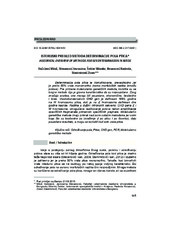Приказ основних података о документу
Historical overview of methods for sex determination in birds
Istorijski pregled metoda determinacije pola ptica
| dc.creator | Vučićević, Miloš | |
| dc.creator | Stevanović, Jevrosima | |
| dc.creator | Šekler, Milanko | |
| dc.creator | Resanović, Radmila | |
| dc.creator | Stanimirović, Zoran | |
| dc.date.accessioned | 2020-06-03T14:05:32Z | |
| dc.date.available | 2020-06-03T14:05:32Z | |
| dc.date.issued | 2016 | |
| dc.identifier.issn | 0350-2457 | |
| dc.identifier.uri | https://vet-erinar.vet.bg.ac.rs/handle/123456789/1345 | |
| dc.description.abstract | Determining the sex in birds is very difficult, primarily because over 50% of species is monomorphic (no morphological differences between the sexes). Before the application of molecular genetic methods, there were used numerous methods all of which were unreliable. Because of the importance of the analyses, they have to be reliable, economical, safe and prompt. Highly conserved CHD gene is defined in 1995. on W chromosome in birds, while on Z chromosome it was defined two years later. The difference in the length of the intronic sequences of CHD gene of Z and W chromosomes enables the distinguishing of the sexes after amplification of specific fragments by the application of specific primers. Molecular genetic methods have the supremacy over all the other methods because, except for being safe (both for birds and people), they provide reliable results, and also can be applied in all bird species. | en |
| dc.description.abstract | Determinacija pola ptica je komplikovana, prevashodno jer je preko 50% vrsta monomorfno (nema morfoloških razlika između polova). Pre primene molekularno genetičkih metoda, koristile su se brojne metode čija je glavna karakteristika da su nepouzdane. Zbog značaja analiza, one moraju biti pouzdane, ekonomične, bezbedne i brze. Visokokonzervativni CHD gen je definisan 1995. godine na W hromozomu ptica, dok je na Z hromozomu definisan dve godine kasnije. Razlika u dužini intronskih sekvenci CHD gena Z i W hromozoma, omogućava razlikovanje polova nakon amplifikacije specifičnih fragmenata primenom specifičnih prajmera. Molekularno genetičke metode imaju primat nad svim ostalim metodama jer osim toga što su bezbedne za izvođenje (i po pticu i po čoveka), daju pouzdane rezultate, a mogu se koristiti kod svih vrsta ptica. | sr |
| dc.publisher | Univerzitet u Beogradu - Fakultet veterinarske medicine, Beograd | |
| dc.rights | openAccess | |
| dc.rights.uri | https://creativecommons.org/licenses/by/4.0/ | |
| dc.source | Veterinarski Glasnik | |
| dc.subject | sex determination | en |
| dc.subject | birds | en |
| dc.subject | CHD gene | en |
| dc.subject | PCR | en |
| dc.subject | molecular genetic methods | en |
| dc.subject | određivanje pola | sr |
| dc.subject | ptice | sr |
| dc.subject | CHD gen | sr |
| dc.subject | PCR | sr |
| dc.subject | molekularno genetičke metode | sr |
| dc.title | Historical overview of methods for sex determination in birds | en |
| dc.title | Istorijski pregled metoda determinacije pola ptica | sr |
| dc.type | article | |
| dc.rights.license | BY | |
| dcterms.abstract | Шеклер, Миланко; Стевановић, Јевросима; Станимировић, Зоран; Ресановић, Радмила; Вучићевић, Милош; Историјски преглед метода детерминације пола птица; Историјски преглед метода детерминације пола птица; | |
| dc.citation.volume | 70 | |
| dc.citation.issue | 3-4 | |
| dc.citation.spage | 145 | |
| dc.citation.epage | 157 | |
| dc.citation.other | 70(3-4): 145-157 | |
| dc.citation.rank | M51 | |
| dc.identifier.doi | 10.2298/VETGL1604145V | |
| dc.identifier.fulltext | https://vet-erinar.vet.bg.ac.rs/bitstream/id/312/1344.pdf | |
| dc.type.version | publishedVersion |

